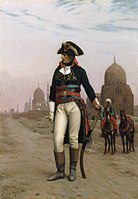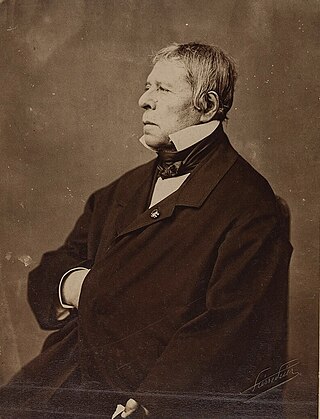
Jean-Auguste-Dominique Ingres was a French Neoclassical painter. Ingres was profoundly influenced by past artistic traditions and aspired to become the guardian of academic orthodoxy against the ascendant Romantic style. Although he considered himself a painter of history in the tradition of Nicolas Poussin and Jacques-Louis David, it is his portraits, both painted and drawn, that are recognized as his greatest legacy. His expressive distortions of form and space made him an important precursor of modern art, influencing Henri Matisse, Pablo Picasso, and other modernists.
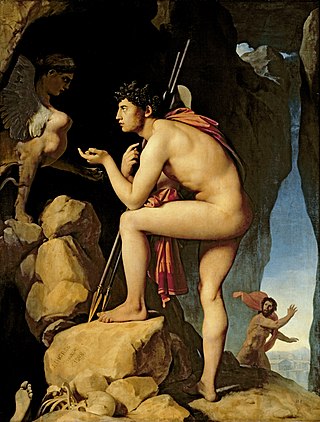
Oedipus was a mythical Greek king of Thebes. A tragic hero in Greek mythology, Oedipus fulfilled a prophecy that he would end up killing his father and marrying his mother, thereby bringing disaster to his city and family.

Seven Against Thebes is the third play in an Oedipus-themed trilogy produced by Aeschylus in 467 BC. The trilogy is sometimes referred to as the Oedipodea. It concerns the battle between an Argive army, led by seven champions including Polynices who were called the Seven against Thebes, and the army of Thebes led by Eteocles and his supporters. The trilogy won the first prize at the Athens City Dionysia. The trilogy's first two plays, Laius and Oedipus, as well as the satyr play Sphinx, are no longer extant.
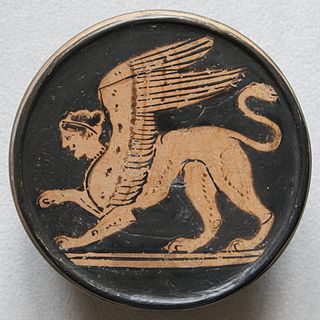
A sphinx is a mythical creature with the head of a human, the body of a lion, and the wings of an eagle.
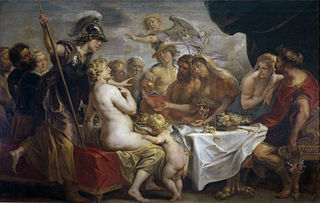
A figure painting is a work of fine art in any of the painting media with the primary subject being the human figure, whether clothed or nude. Figure painting may also refer to the activity of creating such a work. The human figure has been one of the constant subjects of art since the first Stone Age cave paintings, and has been reinterpreted in various styles throughout history.

Jean-Léon Gérôme was a French painter and sculptor in the style now known as academicism. His paintings were so widely reproduced that he was "arguably the world's most famous living artist by 1880." The range of his works includes historical paintings, Greek mythology, Orientalism, portraits, and other subjects. He is considered one of the most important painters from the academic period. He was also a teacher with a long list of students.

François Auguste Ferdinand Mariette was a French scholar, archaeologist and Egyptologist, and the founder of the Egyptian Department of Antiquities, the forerunner of the Supreme Council of Antiquities.

Antoine-Jean Gros was a French painter of historical subjects. He was granted the title of Baron Gros in 1824.
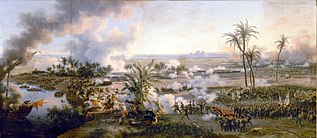
The Battle of the Pyramids, also known as the Battle of Embabeh, was a major engagement fought on 21 July 1798, during the French Invasion of Egypt. The battle took place near the village of Embabeh, across the Nile River from Cairo, but was named by Napoleon after the Great Pyramid of Giza visible nearly nine miles away.
The Infernal Machine, or La Machine Infernale is a French play by the dramatist Jean Cocteau, based on the ancient Greek myth of Oedipus. The play initially premiered on April 10, 1934 at the Theatre Louis Jouvet in Paris, France, under the direction of Louis Jouvet himself, with costumes and scene design by Christian Bérard. The Infernal Machine, as translated by Albert Bermel, was first played at the Phoenix Theatre, New York, on February 3, 1958, under the direction of Herbert Berghof, with scenery by Ming Cho Lee, costumes by Alvin Colt, and lighting by Tharon Musser.

The French invasion of Egypt and Syria was a military campaign in and occupation of Ottoman territories in Egypt and Syria by French forces under the command of Napoleon during the French Revolutionary Wars. It was the primary purpose of the Mediterranean campaign of 1798, in which the French captured Malta while being followed by the British Royal Navy, whose pursuit was hampered by a lack of scouting frigates and reliable information.

Œdipe (Oedipe) is an opera in four acts by the Romanian composer George Enescu, set to a French libretto by Edmond Fleg. It is based on the mythological tale of Oedipus, as told by Sophocles in Oedipus the King.

Grande Odalisque, also known as Une Odalisque or La Grande Odalisque, is an oil painting of 1814 by Jean-Auguste-Dominique Ingres depicting an odalisque, or concubine. Ingres' contemporaries considered the work to signify Ingres' break from Neoclassicism, indicating a shift toward exotic Romanticism.

Napoleon I on his Imperial Throne is an 1806 portrait of Napoleon I of France in his coronation costume, painted by the French painter Jean-Auguste-Dominique Ingres.

Bonaparte, First Consul is an 1804 portrait of Napoleon Bonaparte as First Consul by Jean-Auguste-Dominique Ingres. The painting is now in the collection of the Curtius Museum in Liège. Posing the hand inside the waistcoat was often used in portraits of rulers to indicate calm and stable leadership.

Oedipus and the Sphinx is an 1864 oil on canvas painting by Gustave Moreau that was first exhibited at the French Salon of 1864 where it was an immediate success. It is now in the Metropolitan Museum of Art. The work was a fresh treatment of the established subject of the meeting between Oedipus and the Sphinx on the road outside Thebes, as described in Sophocles's play Oedipus Rex.

Romulus' Victory Over Acron is a painting completed in 1812 by the French Neoclassical artist Jean-Auguste-Dominique Ingres. Ingres' source for this subject comes from Plutarch's Life of Romulus. The painting depicts the war that resulted from the Roman abduction of the young Sabine women in an effort to remedy the shortage of women in the newly founded city of Rome. In retaliation Acron, the king of the neighbouring tribe, the Caeninenses, declared war upon the Romans. He and his tribesmen were mercilessly defeated and their city sacked by the Romans.

Oedipus and the Sphinx is a painting by the French Neoclassical artist Jean-Auguste-Dominique Ingres. Originally a student work painted in 1808, it was enlarged and completed in 1827. The painting depicts Oedipus explaining the riddle of the Sphinx. An oil painting on canvas, it measures 189 x 144 cm, and is in the Louvre, which acquired it in 1878.

Portrait of Napoleon III is an oil painting of 1861 by the French painter Hippolyte Flandrin, depicting France's Emperor Napoleon III standing in his Grand Cabinet. It is held at the Musée de l'Histoire de France, in Paris. At its first presentation in the Universal Exhibition in 1862, the painting attracted praise for its true-to-life representation of Napoleon III.
Michel Rigo was an artist from Genoa who accompanied the French army under Napoleon Bonaparte in their campaign in Egypt and Syria in 1798. Rigo has been described as "the first Western portraitist to work in Egypt."




